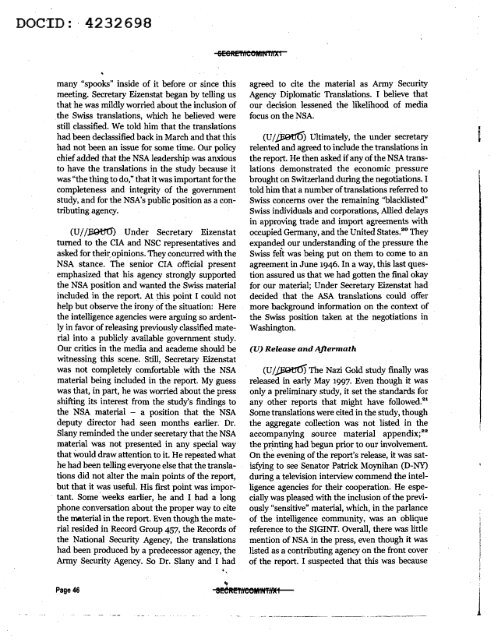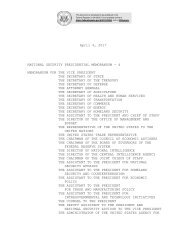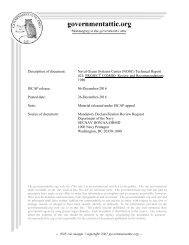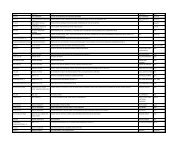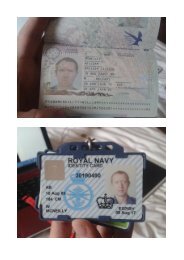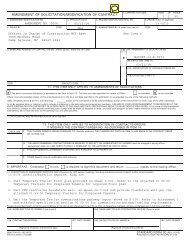government undersecretary
nsa-nazi-gold
nsa-nazi-gold
You also want an ePaper? Increase the reach of your titles
YUMPU automatically turns print PDFs into web optimized ePapers that Google loves.
DOCID: · 4232698<br />
. SE6RETffCOMINT11X I<br />
many "spooks" inside of it before or since this<br />
meeting. Secretary Eizenstat began by telling us<br />
that he was mildly worried about the inclusion of<br />
the Swiss translations, which he believed were<br />
still classified. We told him that the translations<br />
had been declassified back in March and that this<br />
had not been an issue for some time. Our policy<br />
chief added that the NSA leadership was anxious<br />
to have the translations in the study because it<br />
was "the thing to do," that it was important for the<br />
completeness· and integrity of the <strong>government</strong><br />
study, and for the NSA's public position as a contributing<br />
agency.<br />
(U I I.BQi:10) Under Secretary Eizenstat<br />
turned to the CIA and NSC representatives and<br />
asked for their/opinions. They concurred with the<br />
NSA stance. The senior CIA official present<br />
emphasized that his agency strongly supported<br />
the NSA position and wanted the Swiss material<br />
included in the report. At this point I could not<br />
help but observe the irony of the situation: Here<br />
the intelligence agencies were arguing so ardently<br />
in favor of releasing previously classified material<br />
into a publicly available <strong>government</strong> study.<br />
Our critics in the media and academe should be<br />
witnessing this scene. Still, Secretary Eizenstat<br />
was not completely comfortable with the NSA<br />
material being included in the report. My guess<br />
was that, in part, he was worried about the press<br />
shifting its interest from the study's findings to<br />
the NSA material - a position that the NSA<br />
deputy director had seen months earlier. Dr.<br />
Slany reminded the under secretary that the NSA<br />
material was not presented in any special way<br />
that would draw attention to it. He repeated what<br />
he had been telling everyone else that the translations<br />
did not alter the main points of the report,<br />
but that it was useful. His first point was impor-<br />
. tant. Some· weeks earlier, he and I had a long<br />
phone conversation about the proper way to cite<br />
the Illftterial in the report. Even though the material<br />
resided in Record Group 457, the Records of<br />
the National Security Agency, the translations<br />
had been produced by a predecessor agency, the<br />
Army Security Agency. So Dr. Slany and I had<br />
agreed to cite the material as Army Security<br />
Agency Diplomatic Translations. I believe that<br />
our decision lessened the likelihood of media<br />
focus on the NSA.<br />
(U I ;jPdf:J6) Ultimately, the under secretary<br />
relented and agreed to include the translations in<br />
the report. He then asked if any of the NSA translations<br />
demonstrated the economic pressure<br />
brought on Switzerland during the negotiations. I<br />
told him that a number of translations referred to<br />
Swiss concerns over the remaining "blacklisted"<br />
Swiss individuals and corporations, Allied delays<br />
in approving trade and import agreements with<br />
occupied Germany, and the United States. 20 They<br />
expanded our understanding of the pressure the<br />
Swiss feit was being put on them to come to an<br />
agreement in June 1946. In a way, this last question<br />
assured us that we had gotten the final okay<br />
for our material; Under Secretary Eizenstat had<br />
decided ·that the ASA translations could offer<br />
more background information on the context of<br />
the Swiss position taken at the negotiations in<br />
Washington.<br />
(U) Release and Aftermath<br />
(UI~ The Nazi Gold study finally was<br />
released in early May 1997. Even though it was<br />
only a preliminary study, it set the standards for<br />
any other reports that might have followed. 21<br />
Some translations were cited in the study, though<br />
the aggregate collection was not listed in the<br />
accompanying source material appendix; 22<br />
the p~nting had begun prior to our involvement.<br />
On the evening of the report's release, it was satisfying<br />
to see Senator Patrick Moynihan (D-NY)<br />
during a television interview commend the intelligence<br />
agencies for their cooperation. He especially<br />
was pleased with the inclusion of the previously<br />
"sensitive" material, which, in the parlance<br />
of the intelligence community, was an oblique<br />
reference to the SIGINT. Overall, there was little<br />
mention of NSA in the press, even though it was<br />
listed as a contributing agency on the front cover<br />
of the report. I suspected that this was because<br />
Page 46<br />
Oj<br />
8EtRE'fii'eOMINT/RE1<br />
-- -··--·------- .----··· -------- 1


